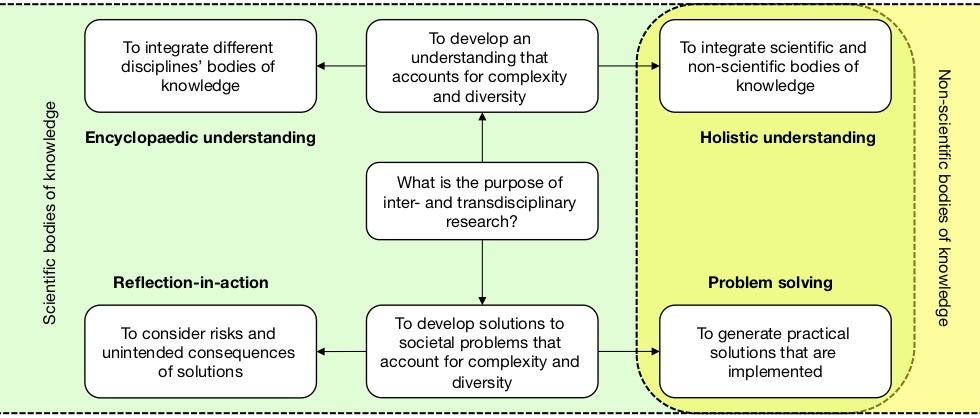Network for Transdisciplinary Research
Addressing societal challenges
Transdisciplinary research for what?
Figure 1 shows four key purposes of inter- and transdisciplinary research. In its definition, the US National Academy of Sciences cites two purposes: advancing fundamental understanding and solving problems. Within each of these purposes, we can distinguish two sub-purposes.

Figure 1: Four key purposes of inter- and transdisciplinary research, each leading to a different definition: encyclopaedic understanding, holistic understanding, problem solving, and reflection-in-action.
This figure is the result of work in progress and should not to be taken as a comprehensive analysis of all possible purposes.
In order to understand a phenomenon in a way that accounts for complexity and diversity, it is necessary to integrate the expertise and perspectives of diverse disciplines and various other bodies of specialised knowledge. Combining these bodies of knowledge enables us to develop a comprehensive understanding and to overcome the “symmetry of ignorance” [1, p325] .
- When bodies of knowledge from different scientific disciplines are combined, td-net refers to this as contributing to an encyclopaedic understanding [cf. 2].
- When scientific and local or traditional bodies of knowledge are combined, td-net refers to this as contributing to a holistic understanding [cf. 3, 4] .
In order to develop solutions to societal problems that account for complexity and diversity, it is likewise necessary to combine different bodies of knowledge.
- When scientific and non-scientific bodies of knowledge are integrated to support concrete problem-solving efforts, td-net refers to this as serving the purpose of problem solving. [cf. 5, 6].
- When different scientific bodies of knowledge are integrated to account for the risks and unintended consequences of current or planned problem-solving efforts, td-net refers to this as serving the purpose of reflection-in-action [cf. 7, 8].
The four purposes are simplified ideal types [9]. Actual projects may observe several of them without clearly distinguishing between them.
This work represents an initial attempt to systematise the definitions of inter- and transdisciplinarity according to their purpose. It may be used to help structure the many definitions that currently exist. Comments, reviews, and criticisms of the purposes we cite, purposes we may have overlooked, or any possible improvements are always welcome:
td-net@scnat.ch
References
- Rittel, H.W.J., Second-generation design methods, in Developments in design methodology, N. Cross, Editor. 1984, Wiley: Chichester. p. 317-327.
- Repko, A.F., Integrating theory-based insights on the causes of suicide terrorism, in Case studies in interdisciplinary research, A.F. Repko, W.H. Newell, and R. Szostak, Editors. 2012, Sage Publications: Thousand Oaks, Calif. p. 125-157.
- Nicolescu, B., Methodology of transdisciplinarity – Levels of reality, logic of the included middle and complexity. Transdisciplinary Journal of Engineering & Science, 2010. 1(1): p. 19-38.
- Martin, D.H., Two-eyed seeing: a framework for understanding indigenous and non-indigenous approaches to indigenous health research. The Canadian journal of nursing research = Revue canadienne de recherche en sciences infirmieres, 2012. 44(2): p. 20-42.
- Pohl, C. and G. Hirsch Hadorn, Principles for Designing Transdisciplinary Research - proposed by the Swiss Academies of Arts and Sciences. 2007, München: oekom Verlag.
- Hirsch Hadorn, G., et al., eds. Handbook of Transdisciplinary Research. ed. Springer. 2008, Springer: Dordrecht. 448.
- Schön, D.D., The Reflective Practitioner - How Professionals Think in Action. Paperback Edition ed. 1983, Aldershot, Hunts: Ashgate.
- Grunwald, A., "Strategic knowledge for sustainable development. The need for reflexivity and learning at the interface between science and society". International Journal of Foresight and Innovation Policy, 2004. 1: p. 150-167.
- Weber, M.," Die Objektivität sozialwissenschaftlicher und sozialpolitischer Erkenntnis", in Gesammelte Aufsätze zur Wissenschaftslehre, J. Winckelmann, Editor. 1973, J.C.B. Mohr (Paul Siebeck): Tübingen. p. 146-215.
Navigation
Newsletter td-info
td-net
House of Academies
Laupenstrasse 7
P.O. Box
3001 Bern
Switzerland